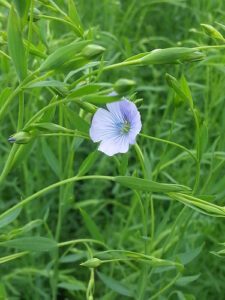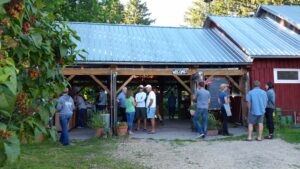Project Overview
Commodities
- Agronomic: flax
Practices
- Crop Production: cover crops, crop rotation
- Education and Training: demonstration, on-farm/ranch research, participatory research
- Farm Business Management: feasibility study
- Production Systems: organic agriculture
- Soil Management: soil analysis, soil quality/health
- Sustainable Communities: employment opportunities, sustainability measures
Summary:
 A flax flower blooms at A to Z Produce and Bakery, Stockholm, Wisconsin. June 2017.[/caption]
A flax flower blooms at A to Z Produce and Bakery, Stockholm, Wisconsin. June 2017.[/caption]
Can new technology revive an ancient textile fiber? Our project explored the feasibility of developing a small-scale, local linen industry. Over two years, we grew textile flax as part of the rotational plan on a diversified organic farm in western Wisconsin. Working in partnership with Taproot Fibre Lab in Port Williams, Nova Scotia and their newly-developed mechanical processing equipment, we turned retted flax straw into salable flax and linen products: long-stapled line flax fiber for handspinning, short-stapled tow fiber and roving for spinning, fiber blending, and papermaking, and tow linen yarns.
Linen is an ancient textile material, cultivated for more than 10,000 years. Cloth made from flax – linen – is an extraordinarily long-lasting and high-quality textile. Immigrants to the upper Midwest brought flax-growing knowledge and the tools for working flax into linen with them when they arrived here in the 19th century, but a local linen industry never took hold; flax is time-consuming to harvest and process, and cotton became the dominant plant-based textile fiber in the United States. Today, cotton and all other natural fibers represent a smaller and smaller percentage of global textile production; replaced by synthetic, petroleum-based cloth. Even so, interest in “local linen” is strong among hand spinners, knitters, weavers, and papermakers in our region. Many people have come to recognize the importance of developing (or rediscovering) options for locally-grown and processed textile materials. Flax was part of a traditional crop rotation in generations past. It grows well in our region without significant inputs, and has the potential to be a locally-grown, sustainable textile crop. Linen cloth is durable, beautiful, and versatile. Flax fiber is a primary ingredient in many high-quality handmade papers, and is valued for its strength and durability.
At this time, there is no industrial-scale or small-scale infrastructure for processing flax straw into finished linen products in the upper Midwest or the US more broadly. Very little textile flax is grown in the upper Midwest at this time, and the crop is often unfamiliar both to local farmers and to hand spinners, and other fiber artists. The small number of people who do grow textile flax are limited in their production capability by having to hand-harvest and hand-process their crop using the same simple tools their ancestors would have employed centuries ago. The lack of processing infrastructure prevents fiber flax from being grown at anything but a very small experimental scale. Lack of processing machinery has been a significant obstacle to the creation (or revival) of flax growing in our region. However, new developments in small-scale processing machinery present the potential to bring local linen production to our region. We believe that our project, using this newly developed processing machinery, demonstrates the viability of flax as a local textile fiber crop.
Our project began to explore the elements of a system of growers and potential end-users who were part of the “ecosystem” of creating a local linen infrastructure in our area. We successfully demonstrated that textile flax production can be incorporated within the existing planting regime of a small, diversified farm, and that production can be scaled to the capacity of a cottage-industry-scaled mill of the type developed by Taproot Fibre Lab. Working with the machinery developed by Taproot, the textile flax we grew was processed into a variety of value-added products which were marketed to end users who used the material in papermaking, handspinning, weaving, and knitting projects.
Project objectives:
Our team grew a modest amount of flax; one half acre in 2017 and 2018. Working in collaboration with Taproot, approximately half of our 2017 crop was transported to Taproot's site in Nova Scotia for processing. The processed flax fiber was used for a variety of purposes; primarily handspinning, weaving, and papermaking. The purpose of the project was twofold; to demonstrate that flax can fit into an existing organic rotation on a diversified farm, and to show that flax and linen products can be produced here for a regional/national market.

Our project emphasized robust outreach to educate the public and potential end users about flax production, processing, and its potential for this area. Outreach was accomplished digitally, using our websites and social media platforms, and in-person, through presentations at regional events focused on agriculture and local fiber/textile production, and regional history.
This project was intended to begin a process exploring the feasibility of building a local linen mill in our area using Taproot's machinery.